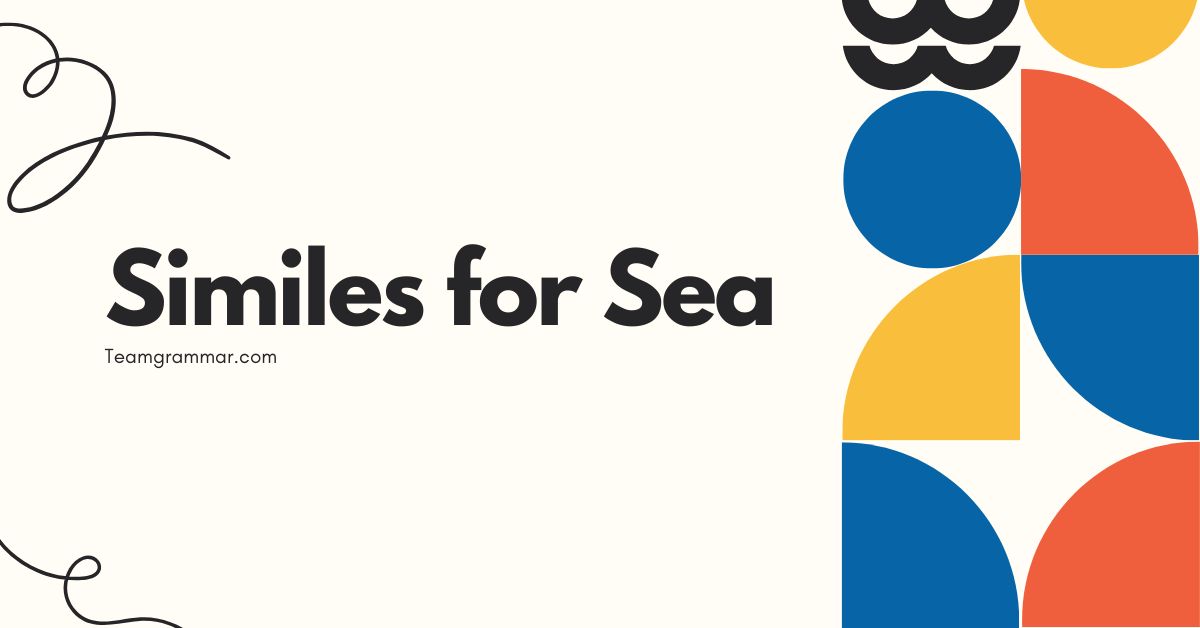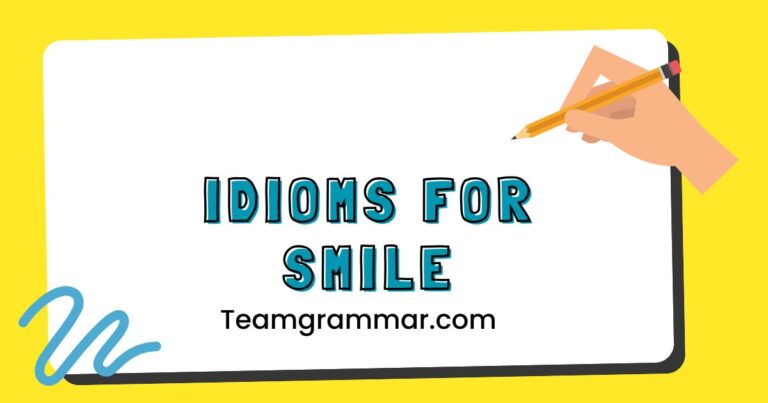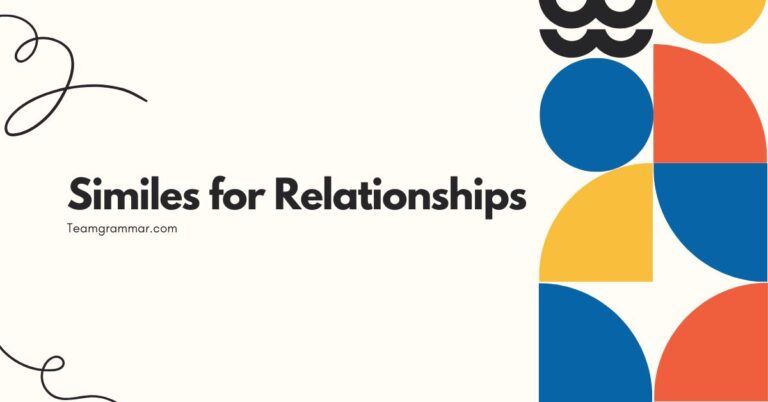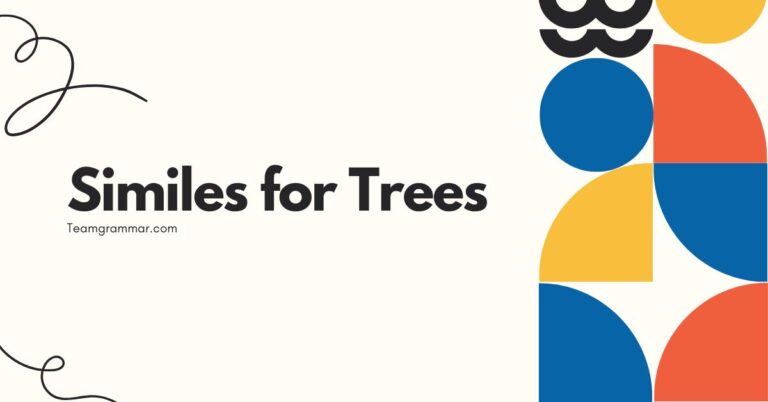37 Similes for Sea: Mastering Figurative Language
Understanding similes is crucial for enriching your writing and comprehension skills. Similes, a cornerstone of figurative language, allow us to draw vivid comparisons, making descriptions more engaging and memorable.
This article focuses specifically on similes related to the sea, exploring how these comparisons can evoke the vastness, power, and mystery of the ocean. This guide is perfect for students, writers, and anyone looking to enhance their command of the English language by mastering the art of crafting and interpreting similes.
Table of Contents
- Introduction
- Definition of a Simile
- Structural Breakdown of Similes
- Types of Sea Similes
- Examples of Similes for Sea
- Usage Rules for Similes
- Common Mistakes with Similes
- Practice Exercises
- Advanced Topics in Similes
- Frequently Asked Questions
- Conclusion
Definition of a Simile
A simile is a figure of speech that directly compares two different things, using the words “like” or “as.” The purpose of a simile is to create a vivid image or to emphasize a particular quality of one thing by associating it with something else. Similes are a fundamental tool in descriptive writing and poetry, enabling writers to convey complex ideas in a relatable and imaginative way.
By drawing parallels between dissimilar items, similes help readers visualize and understand concepts more effectively.
In essence, a simile functions as a bridge, linking the familiar with the unfamiliar. This connection allows for a deeper understanding and appreciation of the subject being described.
For instance, instead of simply stating that the sea is large, a simile might describe it as “as vast as the sky,” immediately conveying the immense scale of the ocean.
Structural Breakdown of Similes
The structure of a simile is relatively straightforward, typically consisting of three main components: the subject, the comparison word (like or as), and the object of comparison. The subject is the entity being described, while the object of comparison is the entity it is being likened to.
The comparison word serves as the connector, explicitly indicating that a comparison is being made. Understanding this structure is crucial for both creating and interpreting similes effectively.
Let’s break down the structure with an example: “The sea was as smooth as glass.” Here, “the sea” is the subject, “as” is the comparison word, and “glass” is the object of comparison. This simple construction allows for a powerful and evocative description of the sea’s calmness.
Variations in simile structure can also occur. Sometimes, the order of the subject and object of comparison may be reversed for emphasis or stylistic effect.
However, the presence of “like” or “as” remains a constant indicator of a simile.
Types of Sea Similes
Similes related to the sea can be categorized based on the specific qualities or characteristics they emphasize. Here are several types of sea similes:
Similes Comparing Size
These similes emphasize the vastness and immensity of the sea, often comparing it to other large-scale entities.
Similes Comparing Movement
These similes focus on the motion of the sea, from gentle ripples to violent waves, drawing parallels with other moving objects or forces.
Similes Comparing Color
These similes highlight the various colors of the sea, from deep blues and greens to shimmering silvers, using comparisons to other colorful objects.
Similes Comparing Sound
These similes emphasize the sounds of the sea, from gentle lapping to crashing waves, drawing parallels with other auditory experiences.
Similes Comparing Texture
These similes focus on the tactile qualities of the sea, such as its smoothness, roughness, or stickiness, using comparisons to other textures.
Similes Comparing Emotion
These similes attribute human emotions to the sea, such as calmness, anger, or sadness, creating a more personal and relatable connection.
Examples of Similes for Sea
The following tables provide extensive examples of similes related to the sea, categorized by the type of comparison they make. Each table contains a variety of similes designed to illustrate the diverse ways in which the sea can be described using figurative language.
Table 1: Similes Comparing the Size of the Sea
This table presents similes that emphasize the vastness and immensity of the sea by comparing it to other large entities. These comparisons help to convey the sheer scale and grandeur of the ocean.
| Simile | Explanation |
|---|---|
| The sea was as boundless as the sky. | Emphasizes the seemingly infinite extent of the sea. |
| The ocean stretched out like an endless blanket. | Conveys the idea of the sea covering a vast area. |
| The sea is as deep as a bottomless pit. | Highlights the immeasurable depth of the ocean. |
| It was like staring into a universe of water. | Suggests the sea is as complex and mysterious as the cosmos. |
| The sea is as wide as the horizon itself. | Links the sea’s width to the distant horizon. |
| The waves rose like towering mountains. | Compares the height of the waves to mountains. |
| The sea’s expanse felt like an uncharted territory. | Evokes the feeling of exploring a vast, unknown area. |
| The ocean was as limitless as imagination. | Suggests the sea’s capacity is beyond measure. |
| The sea roared as loud as a gigantic stadium crowd. | Compares the sea’s roar to the loud sound of a crowd. |
| The bay was as big as a lake. | Relates the bay’s size to that of a large lake. |
| The sea’s depth is like the length of a forgotten memory. | Implicates the sea’s depth is unmeasurable. |
| The sea is as large as the continent of Asia. | Compares the sea to the largest continent in the world. |
| The sea is as large as my dreams. | The sea provides inspiration and feels limitless. |
| The sea is as far as the eye can see. | The neverending sea. |
| The sea is like a giant’s playground. | The sea is a place of fun and enjoyment. |
| The sea is as big as the sky. | The sea is as big as the sky. |
| The ocean is like a world in itself. | The ocean is a world in itself. |
| The sea is like an unending highway. | The sea is like an unending highway. |
| The sea is as big as my heart. | The sea is as big as my heart. |
| The sea is like a giant bowl. | The sea is like a giant bowl. |
| The sea is like a giant mirror. | The sea is like a giant mirror. |
| The sea is like a giant playground. | The sea is like a giant playground. |
| The sea is as big as my mind. | The sea is as big as my mind. |
Table 2: Similes Comparing the Movement of the Sea
This table focuses on similes that describe the various movements of the sea, from gentle ripples to powerful waves. These comparisons highlight the dynamic nature of the ocean and its constant state of flux.
| Simile | Explanation |
|---|---|
| The waves crashed like thunder. | Emphasizes the loud, powerful sound of the waves. |
| The sea moved like a restless sleeper. | Suggests the sea’s constant, uneasy motion. |
| The tide crept in like a silent thief. | Conveys the stealthy, gradual nature of the incoming tide. |
| The waves danced like playful children. | Highlights the lively, energetic movement of the waves. |
| The sea churned like a boiling cauldron. | Evokes the image of turbulent, agitated water. |
| The ship sailed as smoothly as a swan gliding on a lake. | Compares the ship’s movement to the graceful glide of a swan. |
| The currents pulled like invisible hands. | Suggests the unseen force of the ocean currents. |
| The waves rolled in like an army advancing. | Compares the waves’ movement to a large, organized force. |
| The sea surged forward like a released spring. | Highlights the sudden, powerful motion of the sea. |
| The waves broke against the shore like glass shattering. | Conveys the sharp, explosive nature of the breaking waves. |
| The water flowed like a river. | Compares the movement of the water to the flow of a river. |
| The waves are moving like a dancing queen. | The waves are moving like a dancing queen. |
| The sea is moving like a slow-motion movie. | The sea is moving like a slow-motion movie. |
| The sea is moving like a roller coaster. | The sea is moving like a roller coaster. |
| The sea is moving like a washing machine. | The sea is moving like a washing machine. |
| The sea is moving like a merry-go-round. | The sea is moving like a merry-go-round. |
| The sea is moving like a symphony. | The sea is moving like a symphony. |
| The sea is moving like a ballet dancer. | The sea is moving like a ballet dancer. |
| The sea is moving like a snake. | The sea is moving like a snake. |
| The sea is moving like a gentle breeze. | The sea is moving like a gentle breeze. |
| The sea is moving like a storm. | The sea is moving like a storm. |
| The sea is moving like a river. | The sea is moving like a river. |
| The sea is moving like a waterfall. | The sea is moving like a waterfall. |
Table 3: Similes Comparing the Color of the Sea
This table provides similes that describe the various colors of the sea, from deep blues and greens to shimmering silvers. These comparisons help to create a vivid visual image of the ocean’s appearance.
| Simile | Explanation |
|---|---|
| The sea was as blue as a sapphire. | Emphasizes the deep blue color of the sea. |
| The water shimmered like liquid silver. | Conveys the bright, reflective quality of the water. |
| The sea was green like an emerald. | Highlights the vibrant green hue of the sea. |
| The ocean looked like a canvas of turquoise. | Compares the sea’s color to the vibrant blue-green of turquoise. |
| The water was as clear as crystal. | Emphasizes the transparency and purity of the water. |
| The sea was as dark as midnight. | Compares the sea’s darkness to the night sky. |
| The water looked like melted jade. | Suggests the smooth, green appearance of the water. |
| The sea reflected the sky like a mirror. | Highlights the sea’s ability to reflect the colors of the sky. |
| The water sparkled like a million diamonds. | Conveys the brilliant, shimmering quality of the water. |
| The sea was as gray as a stormy sky. | Compares the sea’s color to the dull gray of a storm. |
| The sea is as colorful as a rainbow. | Compares the sea’s color to the rainbow. |
| The sea is as green as grass. | Compares the sea’s color to the grass. |
| The sea is as white as snow. | Compares the sea’s color to the snow. |
| The sea is as black as coal. | Compares the sea’s color to the coal. |
| The sea is as purple as grapes. | Compares the sea’s color to the grapes. |
| The sea is as pink as cotton candy. | Compares the sea’s color to the cotton candy. |
| The sea is as yellow as the sun. | Compares the sea’s color to the sun. |
| The sea is as orange as a pumpkin. | Compares the sea’s color to the pumpkin. |
| The sea is as brown as dirt. | Compares the sea’s color to the dirt. |
| The sea is as light as a feather. | Compares the sea’s color to the feather. |
| The sea is as heavy as an elephant. | Compares the sea’s color to the elephant. |
| The sea is as bright as the moon. | Compares the sea’s color to the moon. |
| The sea is as dark as a cave. | Compares the sea’s color to the cave. |
Table 4: Similes Comparing the Sound of the Sea
This table provides similes that describe the various sounds of the sea, from the gentle lapping of waves to the crashing of thunderous surf. These comparisons help to evoke the auditory experience of being near the ocean.
| Simile | Explanation |
|---|---|
| The waves crashed like a symphony of destruction. | Emphasizes the powerful and overwhelming sound of the waves. |
| The sea whispered like a secret. | Conveys the soft, subtle sound of the sea. |
| The waves roared like a lion. | Highlights the loud, aggressive sound of the waves. |
| The sea sighed like a weary traveler. | Suggests a gentle, mournful sound. |
| The waves lapped against the shore like a gentle heartbeat. | Compares the rhythm of the waves to a comforting heartbeat. |
| The sea sounded like a chorus of voices. | Evokes the complex, layered sounds of the ocean. |
| The waves crashed down like cymbals clashing. | Highlights the sharp, percussive sound of the waves. |
| The sea rumbled like distant thunder. | Suggests a low, ominous sound. |
| The waves splashed like playful laughter. | Conveys a light, cheerful sound. |
| The sea murmured like a lullaby. | Emphasizes the soothing, calming sound of the sea. |
| The sea is as loud as an explosion. | Compares the sea’s sound to the loud sound of an explosion. |
| The sea is as quiet as a mouse. | Compares the sea’s sound to the quiet sound of a mouse. |
| The sea is as noisy as a party. | Compares the sea’s sound to the noisy sound of a party. |
| The sea is as silent as the night. | Compares the sea’s sound to the silent sound of the night. |
| The sea is as deafening as a concert. | Compares the sea’s sound to the deafening sound of a concert. |
| The sea is as peaceful as a church. | Compares the sea’s sound to the peaceful sound of a church. |
| The sea is as melodic as a song. | Compares the sea’s sound to the melodic sound of a song. |
| The sea is as rhythmic as a drum. | Compares the sea’s sound to the rhythmic sound of a drum. |
| The sea is as harmonic as an orchestra. | Compares the sea’s sound to the harmonic sound of an orchestra. |
| The sea is as shrill as a whistle. | Compares the sea’s sound to the shrill sound of a whistle. |
| The sea is as deep as a well. | Compares the sea’s sound to the deep sound of a well. |
| The sea is as shallow as a puddle. | Compares the sea’s sound to the shallow sound of a puddle. |
| The sea is as high as the sky. | Compares the sea’s sound to the high sound of the sky. |
Table 5: Similes Comparing the Texture of the Sea
This table provides similes that describe the tactile qualities of the sea, such as its smoothness, roughness, or stickiness. These comparisons help to engage the reader’s sense of touch and create a more immersive experience.
| Simile | Explanation |
|---|---|
| The sea was as smooth as glass. | Emphasizes the calm, unruffled surface of the sea. |
| The water felt like silk against my skin. | Conveys the soft, luxurious feel of the water. |
| The sea was rough like sandpaper. | Highlights the abrasive, uneven texture of the sea. |
| The water was as sticky as syrup. | Suggests a thick, clinging texture. |
| The waves were like liquid velvet. | Compares the waves’ texture to the soft, flowing nature of velvet. |
| The sea was as cold as ice. | Emphasizes the frigid temperature of the water. |
| The water was as warm as a bath. | Conveys the pleasant, comforting warmth of the water. |
| The sea was as gritty as sand. | Highlights the rough, granular texture of the water. |
| The waves were like a foamy blanket. | Suggests a light, airy texture. |
| The sea was as slick as oil. | Emphasizes the smooth, slippery texture of the water. |
| The sea is as hard as a rock. | Compares the sea’s texture to the hard texture of a rock. |
| The sea is as soft as a cloud. | Compares the sea’s texture to the soft texture of a cloud. |
| The sea is as firm as a mattress. | Compares the sea’s texture to the firm texture of a mattress. |
| The sea is as elastic as a rubber band. | Compares the sea’s texture to the elastic texture of a rubber band. |
| The sea is as viscous as honey. | Compares the sea’s texture to the viscous texture of honey. |
| The sea is as rigid as steel. | Compares the sea’s texture to the rigid texture of steel. |
| The sea is as flexible as plastic. | Compares the sea’s texture to the flexible texture of plastic. |
| The sea is as brittle as glass. | Compares the sea’s texture to the brittle texture of glass. |
| The sea is as resilient as a spring. | Compares the sea’s texture to the resilient texture of a spring. |
| The sea is as dense as lead. | Compares the sea’s texture to the dense texture of lead. |
| The sea is as fluid as water. | Compares the sea’s texture to the fluid texture of water. |
| The sea is as grainy as salt. | Compares the sea’s texture to the grainy texture of salt. |
| The sea is as porous as a sponge. | Compares the sea’s texture to the porous texture of a sponge. |
Usage Rules for Similes
Using similes effectively requires adherence to certain rules. First and foremost, the comparison should be logical and meaningful.
The two things being compared should share a common characteristic that is relevant to the description. Secondly, the simile should enhance the reader’s understanding or create a more vivid image.
Overused or cliché similes should be avoided, as they can detract from the originality and impact of the writing. Finally, ensure that the simile is grammatically correct and fits seamlessly into the surrounding text.
Key Rules:
- Relevance: Ensure the comparison is logical and shares a common trait.
- Originality: Avoid clichés; strive for fresh, unique comparisons.
- Clarity: The simile should enhance understanding, not confuse.
- Grammar: Ensure proper grammatical structure and flow.
Common Mistakes with Similes
One common mistake is confusing similes with metaphors. While both are figures of speech that make comparisons, a simile uses “like” or “as,” whereas a metaphor implies the comparison without these words.
Another mistake is using illogical or nonsensical comparisons that do not enhance understanding. Overusing similes can also weaken the writing, making it seem forced or repetitive.
Finally, using mixed metaphors or similes can create confusing and contradictory images.
Examples of Correct vs. Incorrect Similes:
| Incorrect | Correct | Explanation |
|---|---|---|
| The sea was like a house. | The sea was as vast as a continent. | The incorrect simile is illogical; the correct one highlights size. |
| The waves were like waves. | The waves were like crashing thunder. | The incorrect simile is redundant; the correct one is evocative. |
Practice Exercises
Test your understanding of similes with the following exercises. Each exercise focuses on a different aspect of simile usage, from identifying similes to creating your own.
Exercise 1: Identifying Similes
Identify the similes in the following sentences.
| Question | Answer |
|---|---|
| 1. The sea was as calm as a sleeping child. | as calm as a sleeping child |
| 2. The waves crashed against the rocks. | (No simile) |
| 3. The water shimmered like a thousand stars. | like a thousand stars |
| 4. The ship sailed smoothly across the ocean. | (No simile) |
| 5. The sea roared like an angry beast. | like an angry beast |
| 6. The surface of the water was as smooth as glass. | as smooth as glass |
| 7. The ocean stretched out before them. | (No simile) |
| 8. The sea is as cold as ice. | as cold as ice |
| 9. The sea is as blue as the sky. | as blue as the sky |
| 10. The sea is like a mirror. | like a mirror |
Exercise 2: Completing Similes
Complete the following similes with an appropriate comparison.
| Question | Answer |
|---|---|
| 1. The sea was as deep as _____. | a bottomless well |
| 2. The waves moved like _____. | dancing ribbons |
| 3. The water felt as cold as _____. | a glacier |
| 4. The sea sparkled like _____. | scattered gems |
| 5. The sound of the waves was like _____. | a gentle lullaby |
| 6. The ship was as big as _____. | a city block |
| 7. The sea is as dark as _____. | night |
| 8. The sea is as green as _____. | grass |
| 9. The sea is as white as _____. | snow |
| 10. The sea is as black as _____. | coal |
Exercise 3: Creating Similes
Create your own similes to describe the following aspects of the sea.
| Aspect | Example Simile |
|---|---|
| 1. The vastness of the sea | The sea stretched out like an endless dream. |
| 2. The power of the waves | The waves crashed with the force of a thousand hammers. |
| 3. The color of the water at sunset | The water glowed like molten gold. |
| 4. The sound of the seagulls | The seagulls cried like lonely souls. |
| 5. The texture of the sand | The sand was as soft as powdered sugar. |
| 6. The smell of the ocean | The ocean smelled as fresh as a spring breeze. |
| 7. The depth of the ocean | The ocean is like a mystery. |
| 8. The temperature of the sea | The sea is as warm as a bath. |
| 9. The sea at night | The sea is like a mirror. |
| 10. The sea at sunrise | The sea is as bright as the sun. |
Advanced Topics in Similes
For advanced learners, exploring the nuances of similes can lead to more sophisticated and impactful writing. Consider the use of extended similes, where the comparison is developed over several sentences or even paragraphs.
Also, explore the use of unconventional or unexpected comparisons to create a unique effect. Analyzing the use of similes in literature can provide further insights into their power and potential.
Advanced Techniques:
- Extended Similes: Develop the comparison over multiple sentences.
- Unconventional Comparisons: Use unexpected associations for impact.
- Literary Analysis: Study how similes are used in classic literature.
Frequently Asked Questions
Here are some frequently asked questions about similes:
- What is the difference between a simile and a metaphor?
A simile uses “like” or “as” to make a direct comparison, whereas a metaphor implies the comparison without using these words. For example, “The sea is like a mirror” is a simile, while “The sea is a mirror” is a metaphor.
- Can a simile be a cliché?
Yes, overused similes can become clichés. It’s best to avoid common comparisons and strive for originality.
- How can I make my similes more effective?
Choose comparisons that are vivid, relevant, and unexpected. The more specific and imaginative the comparison, the more impactful it will be.
- Is it possible to overuse similes in writing?
Yes, too many similes can make the writing feel forced and repetitive. Use them sparingly and strategically to enhance your descriptions.
- What are some common examples of similes?
Common examples include “as brave as a lion,” “as busy as a bee,” and “as light as a feather.”
- Can similes be used in everyday conversation?
Yes, similes can be used in everyday conversation to make descriptions more vivid and engaging.
- Are similes only used in writing?
No, similes are used in both writing and speech to create more descriptive and engaging language.
- What makes a simile a good simile?
A good simile is clear, relevant, and creates a vivid image or enhances understanding in a unique way. It should also avoid being clichéd.
- How do I avoid using clichés when writing similes?
Think beyond the obvious. Consider unique qualities of the subject you’re describing and look for less common, more imaginative comparisons.
- How do similes enhance understanding in writing?
Similes create a bridge between the unfamiliar and the familiar. By comparing something to something else that the reader already understands, they can grasp the new concept more easily.
Conclusion
Mastering the art of using similes is a valuable skill for anyone looking to enhance their writing and communication abilities. By understanding the structure, types, and usage rules of similes, you can create more vivid and engaging descriptions.
Remember to avoid clichés, strive for originality, and ensure that your comparisons are logical and meaningful. With practice, you can effectively use similes to bring your writing to life and captivate your audience.
Keep exploring different types of similes and practicing to further enhance your skills. Happy writing!







